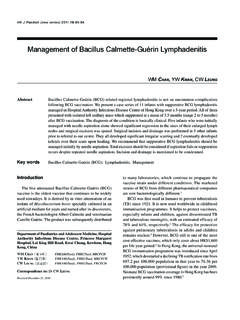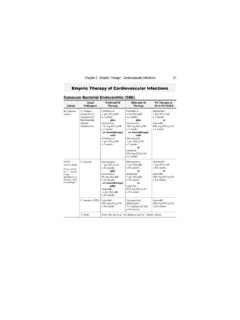Transcription of ISSN 1564-2615 Transboundary Animal Diseases Bulletin
1 ISSN 1564-2615 . EMPRES No. 40 2012. Transboundary Animal Diseases Bulletin E-mail: Bovine tuberculosis at the Animal human ecosystem interface Livelihood-centred Animal health protection: the case of peste des petits ruminants and Bovine tuberculosis commands growing attention from the international commu- small ruminants (page 20). nity. The disease continues to cause signi cant losses in the cattle farming sector Pro ling laboratory capacity in the context of emerging with serious implications on public health, especially in countries where surveillance pandemic threats: the FAO. and control programmes are weak or non-existent. The permanent threat of infec- Laboratory Mapping Tool tion from Animal reservoirs represents a continuous threat and source of infection (page 23). of cattle, making complete eradication dif cult in many developed countries.
2 In FAO Reference Centres (page 28). response to the global importance of bovine tuberculosis, the Food and Agriculture The role of bats in emerging Organization of the United Nations (FAO) has recognized it as a serious infectious zoonoses (page 31). disease that should be controlled at the Animal human ecosystem interface, in EMPRES-i EMA: an integrated the interest of the livestock industry, public health and human livelihoods (page 2). mobile tool for Animal disease eld surveillance (page 34). MEETINGS: Foot-and-mouth disease in Egypt, Libya and OFFLU's contribution to the the Gaza Strip: crisis and response WHO consultation on the composition of in uenza vaccines for the Northern Since February 2012, a severe foot-and-mouth disease (FMD) SAT2 epidemic has Hemisphere (page 36). spread through Egypt and into the Gaza Strip.
3 A separate outbreak of SAT2 has RESOLAB fth annual been detected in Libya. FAO and the European Commission for the Control of Foot- coordination meeting (page 37). and-Mouth Disease (EuFMD) have developed a regional strategic plan for dealing Meetings for IDENTIFY project with SAT2, with the aim of containing spread to neighbouring countries and reduc- planning in the Congo Basin ing the impact in affected areas. Implementation of this strategic plan has begun. (page 38). A regional response is required for the medium and long terms, to prevent further News (page 40). damage to livestock, livelihoods and food security (page 12). Stop the press (page 43). Schmallenberg virus: a new virus threatening livestock farming in Europe In mid-December 2011, a novel vector-borne orthobunyavirus, the Schmallenberg virus (SBV), was identi ed in Europe.
4 As of June 2012, cases of congenital malformations and stillbirths at- tributed to this new virus were reported in Belgium, France, Ger- many, Italy, Luxembourg, the Netherlands, Spain and the United Kingdom of Great Britain and Northern Ireland. FAO, the World Organisation for Animal Health (OIE) and the World Health Orga- nization (WHO) closely monitored the situation of SBV in animals and the potential implications for Animal and human health. The evidence to date indicates that there are no human cases associ- ated with the Animal cases in the countries affected (page 17). FAO Animal Production and Health Division EMPRES Transboundary Animal Diseases Bulletin 40. Tuberculosis Bovine tuberculosis at the Animal human ecosystem interface Introduction Bovine tuberculosis is a chronic disease of animals caused primarily by Mycobacterium bovis (M.)
5 bovis ), a member of the M. tuberculosis complex. The disease is character- ized by progressive development of speci c granulomatous lesions or tubercles in lung tissue, lymph nodes or other organs. The incubation period ranges from months to years, but acute stages of the disease can develop during the course of infection, when lesions progress rapidly. Bovine tuberculosis is an important disease in livestock and in a wide range of wild Animal species worldwide. Bovine species, including bison and buffaloes, are particu- larly susceptible to the disease, but nearly all warm-blooded animals can be affected. M. bovis is also known to affect humans, causing a serious public health problem when it becomes endemic. Similar to the human form of tuberculosis, bovine tuberculosis is commanding growing attention from the international community.
6 This is because of the serious increase in the number of infected herds and the subsequent effect on Animal pro- Bovine tuberculosis duction, combined with the signi cant impact of M. bovis infection on public health, is an important disease and the permanent threat of infection from Animal reservoirs. Despite the long history in livestock and in a wide of disease recognition, the epidemiology of M. bovis is not well understood, espe- range of wild Animal cially in wildlife. In some developed countries, the disease has been eliminated from species worldwide the livestock population, but in other countries wildlife species have been identi ed as reservoir hosts, representing a continuous threat and source of infection of cattle and making complete eradication dif cult. In less developed countries, the disease is maintained in bovines and continues to cause signi cant losses in the cattle farming sector, with serious implications for public health, especially where there is no effec- tive surveillance and control programmes are weak or non-existent.
7 In response to the global importance of bovine tuberculosis for both Animal and public health, the Food and Agriculture Organization of the United Nations (FAO) has recognized it as a priority infectious disease that should be controlled at the Animal human ecosystem interface, through national and regional efforts. This article does not aim to provide a comprehensive description of bovine tuber- culosis, which can be found elsewhere (Michel, M ller and van Helden, 2010; Thoen et al., 2009), but rather to outline the main features of bovine tuberculosis in cattle and wildlife, the impact of the disease on public health, and perspectives on its con- trol, with particular reference to the situation in developing countries. Global distribution and socio-economic impact The geographical distribution of bovine tuberculosis has changed drastically over recent decades.
8 Prior to the introduction of control measures and milk pasteurization in de- veloped countries, tuberculosis was widely distributed throughout the world. Eradica- 2 FAO Animal Production and Health Division EMPRES Transboundary Animal Diseases Bulletin 40. Figure 1: Geographical distribution of bovine tuberculosis (BTB) for 2010 and 2011 based on OIE six monthly reports 2010 2011. Source: OIE WAHID adapted by FAO EMPRES-i. tion programmes based on surveillance and test-and-slaughter policies to clear herds of infected animals virtually eliminated tuberculosis from livestock in many developed countries. Today, many countries in Europe and North America, and Australia are free of the disease or close to its complete eradication in livestock. However, the maintenance of M. bovis infection in wildlife species has signi cantly compromised eradication ef- forts in countries such as Ireland, New Zealand, the United Kingdom of Great Britain and Northern Ireland and parts of the United States of America (Thoen et al.)
9 , 2009). In developing countries, data on the prevalence of bovine tuberculosis are minimal, and the information available may not represent the true epidemiological status of the disease. Although bovine tuberculosis is noti able in many countries, it is often under- reported, particularly in countries that lack effective disease surveillance and reporting systems. The insidious nature of the disease, which does not cause fulminating out- breaks with high mortality, is likely to decrease recognition and reporting, leading to a lack of measures for its control. Despite disease underreporting in developing countries, however there is suf cient evidence to indicate not only that the prevalence of disease is higher in the developing nations, but also that in the absence of national control and eradication programmes, it is increasing worldwide, particularly in Africa, Asia and Latin America (Thoen et al.
10 , 2009). According to the World Animal Health Information Database (WAHID) of the World Organisation for Animal Health (OIE), 70 countries reported bovine tuberculosis cases in their cattle populations in 2010, and 49 countries in 2011 (Figure 1). The economic impact of bovine tuberculosis on livestock production is extremely dif- cult to determine accurately. The disease decreases livestock productivity and may be economically devastating for the cattle industry, especially the dairy sector. Milk yields and draft power can be signi cantly reduced, with direct effects on the livelihoods of poor livestock holders. Most important is the impact of infection in humans par- ticularly women and children, who appear to be more susceptible to the disease in countries with poor socio-economic conditions and weak veterinary and public health services.
















